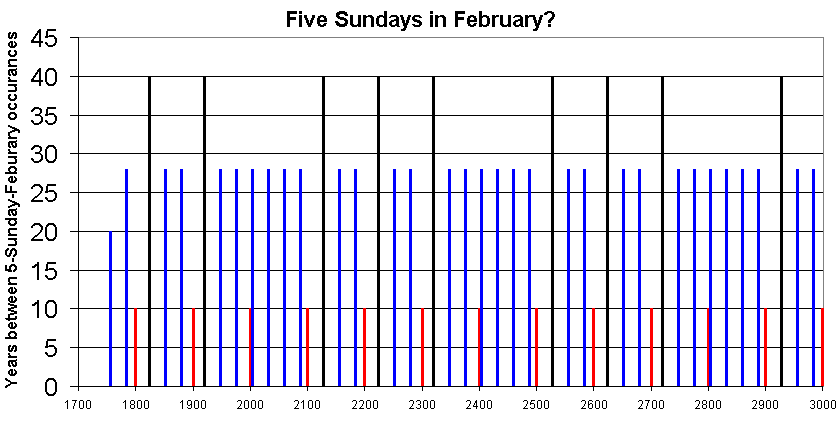
Well, we have a 28 year calendar - it repeats day for date every 28 years ... sort of. We've got leap years every 4 years (sort of) and seven days in a week, so the calendar cycles around again every 28 years, sort of.
Ok, enough with the sort of .. why am I "qualifying" this? Well, we have these these other rules in the leap year system that says if the year is divisible by 100, it is not a leap year ... but, if it is divisible by 400, then it is again! (2000 was one of those years .. divide by 4, yes, but divide by 100, so no, but divide by 400, so yes it was a leap year! So, those weird centrury marks that don't divide by 400 will through off our 28 year calendar, for a few years. [If you haven't seen my 28 year page .. oh, it is a must see!]
Why the big deal about 5 Sundays in February? Well, Leap years have 29 days in February .. the only time that February might possibly have 5 Sundays in it (or Mondays, or Tuesdays, you get my drift ... because I'm writing this in the year 2004, Sunday is the day of interest ...). So, every 28 years, counting back and forth from 2004, February has 5 Sundays? No, weren't you paying attention .. those silly century years will throw us off ...
So, let's take a look from the years 1750 to 3000 to see when we have 5 Sundays in February ... 41 times .. thus an average of about every 30 years ... what? Where did 30 come from? Well, after each of those those pesky centrury marks (that are not leap years), we have to wait a little longer (40 years) to get back on track, then it goes back to 28 years ... thus the average is longer than 28.
Here are the years listed below, grouped by century. Notice the only time we can fit four 5-Sunday-Februarys into a century is during the "good" centuries! (Otherwise we get that 40 year gap for the first 5-Sunday-February, and not enough time to fit four in.) Also, there was a 5-Sunday-February in 1736, but then in 1752 there was the Gregorian Reformation (some days got chopped out of September 1752 to clean up the shifts that were occuring before the 100/400 rules were added). [See this link to see what that September looked like!] There is thus a 20 year gap between those two dates, so we will start our counting with 1756 ....
1736*,1756*,1784
1824,1852,1880
1920,1948,1976
2004,2032,2060,2088
2128,2156,2184
2224,2252,2280
2320,2348,2376
2404,2432,2460,2488
2528,2556,2584
2624,2652,2680
2720,2748,2776
2804,2832,2860,2888
2928,2956,2984
Here is a graph of the years since the last 5-Sunday-February .. The RED lines are the century marks. The BLACK lines are the 40 year waits. The BLUE lines are the 28 year waits. Notice, after most red lines is a black line .. wait 40 years between 5-Sunday-Februarys - but not 2000, 2400, 2800!

Return to the Astronomy Main Page
Of the 447 visitors, you are the most recent!.